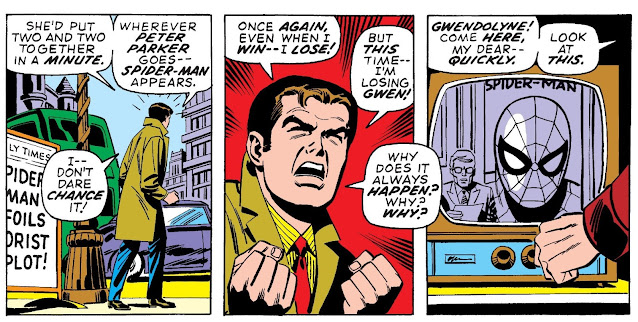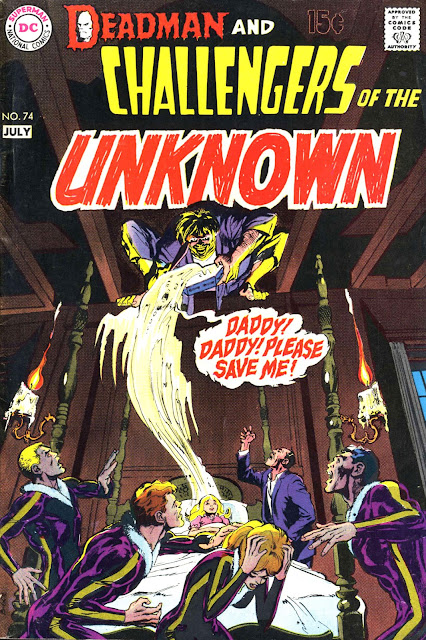AMAZING SPIDER-MAN #95 April 1971
'Spidey fights in London!' declares the cover of THE AMAZING SPIDER-MAN #95, dated April 1971, but on sale from January that year. The cover is a typical all-action picture of the web-slinger swinging past the city's Tower Bridge while being shot at by a number of London's criminals, one of whom is firing from the roof of a double-decker bus. Meanwhile three bobbies are energetically joining the fray, truncheons drawn.
The story entitled TRAP FOR A TERRORIST takes place shortly after the death of Gwen Stacey's father, for which our hero has wrongly been blamed. Gwen has departed for London at the invitation of her uncle several issues earlier, leaving Peter Parker in #94 questioning how much his alter-ego has cost him over the years--
And as Spider-Man hurtles across the sky of New York in #95 he finds he cannot get her out of his mind--
And so, courtesy of Stan Lee's story and John Romita's art we embark upon a transatlantic voyage to London where Peter hopes to find Gwen--
Of course things aren't quite as straightforward as he would have hoped, and no sooner has the plane landed in Britain than the passengers are alerted that terrorists have planted a bomb under the landing ramp. Parker snatches an opportunity to change into his super-hero outfit and swiftly neutralises the danger--
But since the terrorists have managed to escape, Spidey elects to try hunting them down, confident that the Police will fail to catch them before they harm the hostages they've taken-- an American Delegate and his young son whom Parker had chatted to on the plane.
I was intrigued to see a Marvel Super-hero story located in London, a city I know well, and would like to think that John Romita embarked upon a fact-finding mission to the city in the Summer of 1970. I'd like to picture him sitting beside the Thames filling his sketchbook with images, taking in the atmosphere of Leicester Square, strolling along Oxford Street or gazing up at the splendor of St Paul's Cathedral. Alas, I fear the truth to be that he would have simply leafed through a book at the nearest library or sifted through a few picture postcards for photo-references. Nevertheless, it's interesting for me to see how he interprets through his drawings places I myself have been to countless times.
"I've got to keep criss-crossing the city," comments Spider-Man swinging past a red-uniformed guard standing before his sentry-box.
And indeed he does. Presumably he is at Buckingham Palace at this point, though it does seem less secure than it would actually have been in the Seventies, its huge gates only opening during the changing of the guards--
The position of the guardsman is a little odd, since Romita has placed a small courtyard between his sentry-box and the building, whereas in reality they are much closer, and the low fence and hedge seems to have come straight from his imagination--
Maybe the artist's concept of the Palace was based more on ideas such as this E.H. Shepard illustration from A.A. Milne's from WHEN WE WERE VERY YOUNG with its ease of access--
I guess Spider-Man was lucky he visited the palace after some renovations were done in 1970, or this is what he'd have been swinging past--
Next Spidey appears to be clambering across a monument of some kind. Could this be the monument to the Great Fire of London? The decoration on it is certainly quite similar, if not exactly the same--
The only problem is that if this is that particular monument then Spider-Man must have suddenly grown incredibly in size-- here is a picture of the same monument with people clearly seen visiting the cage at the top--
In the next frame the mini-skirted dolly and the bowler-hatted city-gent are walking along the Albert Embankment-- The ornate streetlamp gives away this location, these Victorian lamps line both sides of the river--
It's likely that Spidey has crossed the Thames and is swinging over the South Bank of the river here, since the building coloured yellow in the background resembles the County Hall building located alongside Westminster Bridge--
Next he's crossed back across the river again and headed up to Piccadilly Circus, his to-ing and fro-ing reflecting his changing thoughts as he muses on the sense of duty he feels as a Super-hero--
Romita has represented the advertising hoardings of the late 60s/early 70s fairly accurately, as this postcard image from around that period reveals--
I'm finding the next location harder to pinpoint-- I'd love to say it's The Strand, the busy street that feeds past Charing Cross Station into Trafalgar Square, but it can't be. The building on the left looks close enough to being Westminster Abbey to place this picture a good ten minutes brisk walk away--
While the orange building at the centre reminds me more of the Church of St Martin's in the Fields, itself perched at one corner of Trafalgar Square close to the National Gallery-- The triple-stemmed lamp at the centre of the frame is too common-place to determine even roughly where this might be--
But the biggest conundrum is the clock. I'd love to say I know exactly in London where this clock is, but I'm afraid I don't. And to be honest I don't think it is in London at all. I think it's a long, long way away, back in New York city--
Then I'm guessing Spidey has returned via Shaftsbury Avenue to Piccadilly, I'm assuming the feature in the top corner is the statue of Eros-- Though I could be wrong, as if so it's not a great likeness to the actual monument--
Then we've gone up-river to Tower Bridge, glimpsed in this frame--
It's here that our hero finally spots the villains' car as he swings across the bridge--
One of London's most iconic sights, of course, Tower Bridge is then the scene of the fight promised on the book's cover--
It's not quite as dramatic as the cover suggests, however, Spider-Man actually overcoming all the crooks before the Police turn up, and Romita doesn't seem confident enough to depict the bridge prominently in any way at this point--
Having discovered that the hostages are no longer in the terrorists' car, Spidey sets about to find them, sighting Big Ben in a clue to the readers (spoiler alert!) that the delegate and his son might be somewhere close to the famous clock-tower--
But I am reminded at this point of something else about the cover image. The main action is taking place at Tower Bridge, while in the background is the unmistakeable sight of the Big Ben clocktower and the Houses of Parliament. Indeed, the two locations are revealed in the story too to be incredibly close together, seemingly just a few minutes walk away along the Thames--
In reality they are two and a half miles apart, the curve in the river meaning they would not be in any way visible to each other like this-- On the map, Big Ben looks out over Westminster Bridge, labelled No.3, Tower Bridge is adjacent to Tower Hill and labelled No.10--
Spidey also takes in a few other landmarks as he searches for the delegate and his son-- Starting at the left, there's Big Ben itself of course, the next building in the image must be the Houses of Parliament themselves-- Then there's the spire of the church at Spitalfields, which anyone who has read Alan Moore and Eddie Campbell's FROM HELL will undoubtedly recognise-- Alongside that is what appears to be the Centre Point building located where Oxford St, Charing Cross Rd and Tottenham Court Rd meet--
Finding that his exploits across the city have been reported in the press, Parker decides he cannot now approach Gwen or she'll realise he is in fact Spider-Man. As he does so he walks past another of those ornate lamp-posts which seems to have shifted location away from the embankment--
But as he rails against the fact that whenever he seems to win in some way he also loses, unbeknown to him Gwen's own thoughts about him are about to change-- Seeing how Spider-Man rescued the delegate Gwen's uncle points out that "the chap's a bloomin' hero", suggesting that his neice has done the Super-hero "an injustice"--
And as Gwen ponders the veracity of this conclusion, she cannot stop herself from seeing Peter in a different light, disappointed that he hasn't followed after her. While at the same time Parker concludes that Gwen has probably forgotten all about him--



























































Comments
Post a Comment